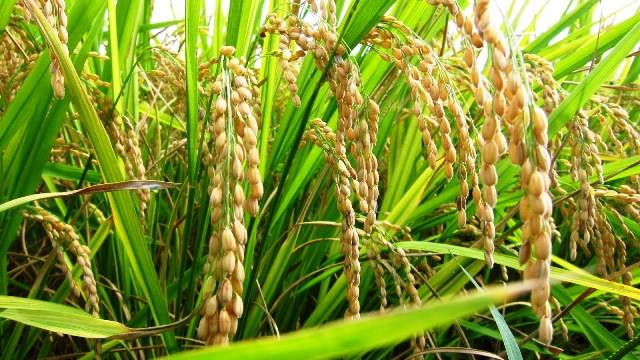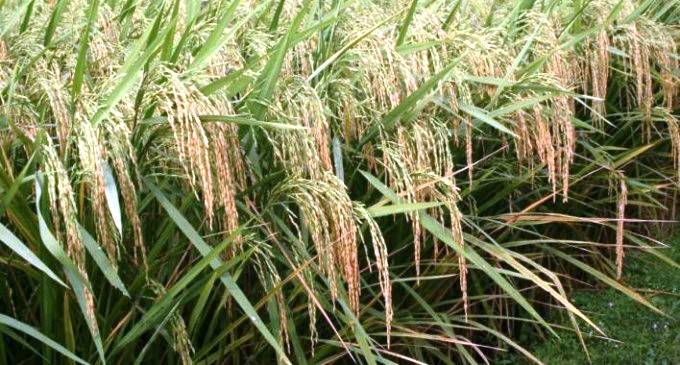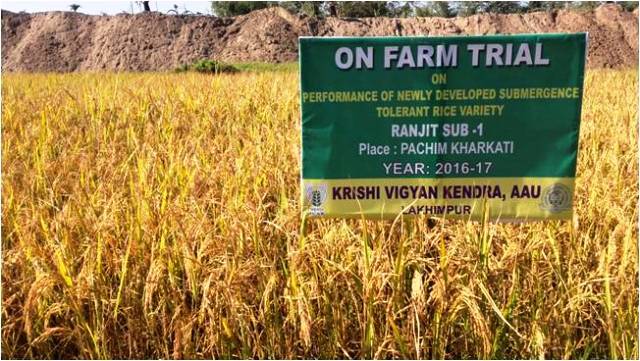
This is for the first time that the two flood-resistant varieties are being tested on a major scale. The two varieties were notified in March this year. Swarna Sub-1 variety was in use earlier, but the latest two varieties are said to be of superior quality in terms of submergence resistance.
With recurring flood-induced crop damages hurting the State’s agriculture, Assam Agriculture University (AAU) and the agriculture department have joined hands for the promotion of submergence-resistant rice varieties.
“The Ranjit and Bahadur varieties will be planted this Kharif season. Preparations are afoot for this, with flood-adaptive cluster demonstration and head-to-head demonstration for farmers in Naoboicha and Bihpuria revenue circles of North Lakhimpur,” Dr. Prabal Saikia, Chief Scientist, Regional Agricultural Research Station under AAU, North Lakhimpur. The two varieties can resist submergence for up to two weeks, and significantly, they do not sacrifice their potential yield because of the prolonged submergence.

“These two varieties can endure underwater conditions for two weeks without losing their potential yield. The existing varieties can barely last five days of submergence,” he said.
Enriched with the ‘submergence’ (sub in short) gene, the two varieties can yield up to five tonnes per hectare on the average.
The agricultural scientists are confident that Ranjit and Bahadur would transform the State’s agricultural scenario for the better. Given that many crop-yielding areas stay under water for many days during floods, these two rice varieties can reduce flood-caused crop loss substantially.

“These two varieties can endure underwater conditions for two weeks without losing their potential yield. The existing varieties can barely last five days of submergence,” he said.
Enriched with the ‘submergence’ (sub in short) gene, the two varieties can yield up to five tonnes per hectare on the average.
The agricultural scientists are confident that Ranjit and Bahadur would transform the State’s agricultural scenario for the better. Given that many crop-yielding areas stay under water for many days during floods, these two rice varieties can reduce flood-caused crop loss substantially.

The success story of submergence tolerant rice varieties in flood-prone Morigaon district observed last year during the ‘On-Farm Testing’ conducted by the Krishi Vigyan Kendra (KVK), Morigaon has enthused the farmers of the district so much that many more have come up to procure the seeds in the coming season.
Last year floods affected 43,602.28 hectares of land in the district. The total population affected was 3,65,142 and the number of villages hit was 341. Paddy grown during the Kharif season is very uncertain due to floods and the farmers know it very well. But still, they went for it because there was a lack of suitable paddy varieties which could withstand submergence during floods. Sometimes flash floods also damaged the crop just after transplantation at the tilling stage. Hence farmers used to go for boro paddy from November to May/June as summer paddy in most of the low-lying areas of the district.
The KVK, Morigaon after analyzing the situation decided to go for on-farm testing (OFT) of submergence tolerant rice varieties Ranjit Sub I and Bahadur Sub I compared to the local variety Swarnamashuri. The initial work on producing the seeds was done by IRRI, Philippines and later scientists from the Regional Agricultural Research Station, Titabor, AAU did the field testing. Thereafter, KVK Morigaon planned to conduct the OFT in five bighas (0.65 hectares) in three locations of the district. Planting materials were brought from RARS, Lakhimpur and distributed among four farmers in Monoha and Borsola areas. Out of the total area, 0.13 hectare was under Ranjit Sub I and the rest 0.42 hectares under Bahadur Sub I. All technical guidance, fertilizers, and training was provided to the farmers.
Heavy rains started in the third week of July 2016 and all the paddy fields including those under OFT were flooded. At Monoha, the farmer, Kameswar Deori, a retired army personnel, was just ready to transplant his seedlings when the floods came. All the seedlings were under water for 12 days at a stretch and apart from that water hyacinth had covered his nursery bed, as the KVK scientists had observed. A helpless Deori, who had invested a lot of money, however did not lose heart as he believed in the new technology. After the floods receded, he again prepared the plot and transplanted the already damaged seedlings.
At Borsola, transplanting had been completed and the crop was at tillering stage when floods came. The crop was submerged for 12 days at a stretch when KVK scientists visited the farms on August 10, 2016. The three farmers Jatin Bora, Chandra Gupta Deka and Balibor Deka, who had so much faith in the new technology, were disheartened but the KVK scientists repeatedly assured that these crops would come up again as they had the submergence gene within them.
All the varieties revived even after submergence and the produce was above expectation. The yield achieved in Ranjit Sub I was 5.6 tons/hectare (747 kg from 0.13 hectare) whereas it was 5.4 tons/hectare (720 kg from 0.13 hectare) in case of Bahadur Sub I. The yield of the local variety could not be estimated as the crop was damaged due to submergence by flood water.















